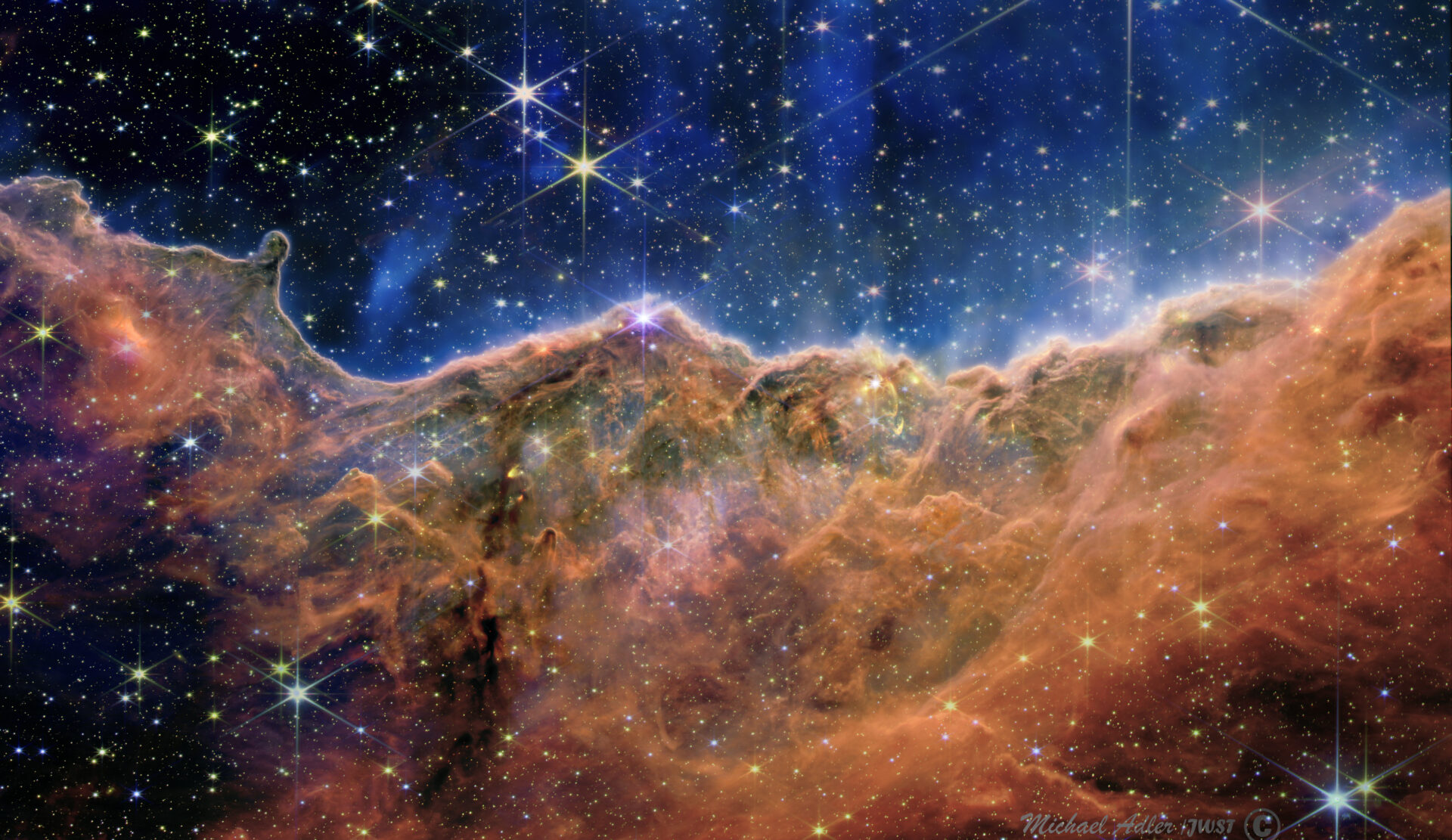Optics: James Webb Space Telescope(JWST)
Mount: JWST
Camera:NIRCAM(JWST Near Infrared Camera)
Filters: 470n,444w,3350m,200w,1870n,090w
Dates/Times: July 2022
Location: Lagrange Point 2 orbit, ~1 million miles from Earth
Exposure Details: Six near infrared filters on the JWST NIRCAM ranging from 900nm to 4700nm
Acquisition: Downloeaded from the MAST website(Mikulski Archive For Space Telescopes)
Processing: Maximdl used to align the data from the six filters and initial three wavelength color image created from the 444w(red), 200w(green), and 090w(blue) filters. Photoshop used to combine this with data from the narrowband 470n(Yellow),335m(Orange), and 187n(Cyan). Stars removed with Star Terminator and processing done in PS Camera Raw with final tweaking and adding stars back in in PS2022.
NGC 3324,Cosmic Cliffs, JWST
Original price was: $65.00.$52.50Current price is: $52.50.
Cosmic Cliffs JWST, NGC 3324 This image is part of the larger Gabriela Mistral Nebula in the southern constellation Carina. It can be seen in the upper rim of the narrowband NGC 3324 image done with a Planewave CDK17 in Chile. https://earthandskyimaging.com/product/ngc-3324-gabriela-nebula/
This image produced by Michael Adler was captured in six infrared wavelengths by NASA’s new James Webb Space Telescope. The image reveals for the first time previously invisible areas of star birth. Called the Cosmic Cliffs, the seemingly three-dimensional picture looks like craggy mountains on a moonlit evening. In reality, it is the edge of the giant, gaseous cavity within NGC 3324, and the tallest “peaks” in this image are about 7 light-years high. The cavernous area has been carved from the nebula by the intense ultraviolet radiation and stellar winds from extremely massive, hot, young stars located in the center of the bubble above the present image that can be seen in the center of image in the above link. The blistering, ultraviolet radiation from the young stars is sculpting the nebula’s wall by slowly eroding it away. Dramatic pillars tower above the glowing wall of gas are resisting this radiation. The “steam” that appears to rise from the celestial “mountains” is actually hot, ionized gas and hot dust streaming away from the nebula due to the relentless radiation. The blue color in the upper portion of the image is close to the actual color caused by emission from Oxygen atoms. This image reveals emerging stellar nurseries and individual stars that are completely hidden in visible-light pictures. Because of Webb’s sensitivity to infrared light, it can peer through cosmic dust to see these objects. Protostellar jets, which emerge clearly in this image, shoot out from some of these young stars. The youngest sources appear as red dots in the dark, dusty region of the cloud. Objects in the earliest, rapid phases of star formation are difficult to capture, but Webb’s extreme sensitivity, spatial resolution, and imaging capability can chronicle these elusive events.
While this image is very similiar to the NASA published image it was done by Michael Adler taking the raw data from the MAST(Makulski Archive for Space Telescopes) website and combining the six separate images into a final image that is close to the NASA image but has been sharpened a bit more to bring out some of the details in the center of the image. Like many of the images done on the current website it is a false color image with light in the second longest wavelength 4400nm in red, followed by the 4700nm in yellow, 3350nm in orange, 2000nm in green, 1870nm in cyan, and finally 900nm in blue. The processing was done in MaximDl to align the images and create a starter RGB image with data from three wavelenths and then completed in Photoshop where the other three wavelenghts(Yellow, Orange, and Cyan)were added in. Advanced processing was done in Photoshop Camera Raw after removing the stars and then adding them back in for the final step.


